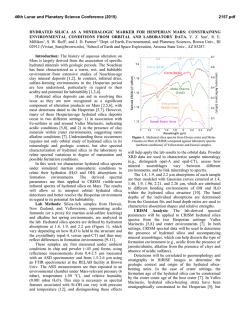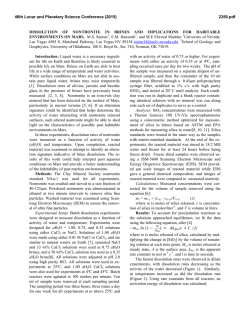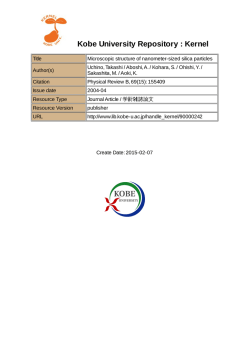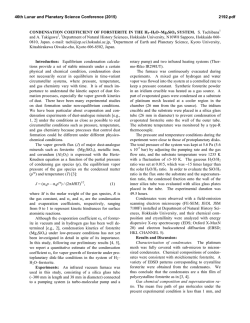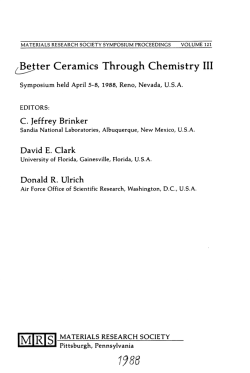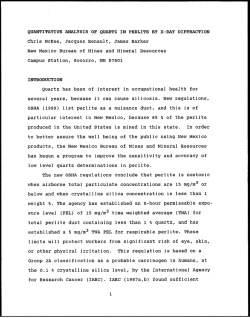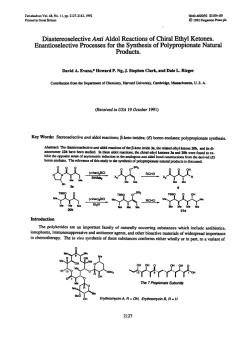
new observations reveal a former hot spring environment with high
46th Lunar and Planetary Science Conference (2015) 1613.pdf NEW OBSERVATIONS REVEAL A FORMER HOT SPRING ENVIRONMENT WITH HIGH HABITABILITY AND PRESERVATION POTENTIAL IN GUSEV CRATER, MARS. S. W. Ruff1, 1School of Earth and Space Exploration, Arizona State University, Tempe, AZ 85287-6305, [email protected]. Introduction: The Spirit rover discovered outcrops and soil composed of opaline silica adjacent to the “Home Plate” feature in Gusev crater. Combined with other geologic evidence, these materials were recognized as the products of a hydrothermal system, the first such example verified on Mars [1]. Fumarolic acid-sulfate leaching of basaltic precursor materials was suggested as the origin of the opaline silica based largely on geochemical arguments. Subsequent analysis by [2] presented stratigraphic and textural observations of the outcrops to advance the hypothesis of a hot spring or geyser-related origin. But the unusual nodular morphology of many of the outcrops and sub-cmscale “digitate protrusions” they contain remained unexplained, precluding a definitive explanation for the silica. New observations of silica sinter deposits produced in small discharge channels from hot springs at El Tatio, Chile provide analogs for all of the enigmatic morphologic features of the Home Plate silica with great specificity. The remarkably similar features appear to be definitive evidence for a comparable hot spring environment in Gusev crater in the past. By analogy with the El Tatio setting, where microbes thrive and are entombed in silica [3], the setting at Home Plate could have been one with high habitability and preservation potential. Observations: Many of the silica occurrences adjacent to Home Plate appear as clusters of nodular rocks with very irregular surfaces, described generically by [2] as digitate protrusions (Fig. 1a). These morphologic aspects were assumed to be due to aeolian erosion of formerly more uniform and massive materials that over time gave rise to the current forms. However, terrestrial examples of certain hot spring silica sinter deposits show that these forms can arise directly through precipitation of silica from solutions. In the Altiplano of northern Chile, the El Tatio geothermal field hosts a range of geysers and hot springs with near-neutral pH, alkali-chloride waters at an elevation 4300 m above sea level. The very low precipitation, high evaporation rates, and diurnal freeze-thaw cycles may contribute to the distinctive sinter textures and morphologic features found there [3]. I have conducted reconnaissance fieldwork at El Tatio and found notable similarities with the Home Plate silica (Fig. 1b). Shallow discharge channels are a common feature of hot springs at El Tatio, which support various microbial species (Fig. 2). These settings produce nodular masses of silica sinter with a highly irregular morphol- ogy that looks strikingly similar to the digitate protrusions documented at Home Plate (Figs. 3 and 4). Similar “columnar sinter” is found in several settings at El Tatio [3], but it is the hot spring discharge channels that present sinter that is the most morphologically similar to Home Plate silica. Figure 1. Opaline silica nodular outcrops near Home Plate (top; Pancam image from sol 778, P2388) and at El Tatio, Chile (bottom) shown at the same scale (hammer ~33 cm). Discussion: As noted by [2], Home Plate silica is distributed in stratiform outcrops on the floors of local topographic lows. This is consistent with the settings at El Tatio in which nodular and columnar sinters are produced in shallow channels and overland flows controlled by the local topography. Sinter breccias are the most widespread sinter type at El Tatio, with the 46th Lunar and Planetary Science Conference (2015) 1613.pdf columnar forms found only in channels with flowing water and on pool margins. Applied to the Home Plate silica, comparable forms suggest similar settings. Figure 2. Shallow discharge channels emanating from hot springs at El Tatio. Water depth is <3 cm but hosts microbial mats (dark material in channels). Figure 3. “Elizabeth Mahon” opaline silica outcrop adjacent to Home Plate (top; Pancam sol 1160, P2582) compared to columnar silica sinter produced in a shallow discharge channel at El Tatio (shown at the same scale; knife ~9 cm) that hosts microbial mats (dark material). Figure 4. Detail of “Elizabeth Mahon” as viewed with the Microscopic Imager (top; sol 1157) and columnar sinter from El Tatio (bottom). Both scenes are ~5 cm across. Conclusions: The columnar sinters that form nodular clusters in shallow hot spring discharge channels at El Tatio provide a remarkable analog to the forms of silica observed adjacent to Home Plate, making a strong case for a comparable setting on Mars. At El Tatio, such settings favor the growth and preservation of microbes, thus the Home Plate silica deposits are an ideal location for searching for past life on Mars. References: [1] Squyres, S. W., et al. (2008), Science, 320, 1063-1067, 10.1126/science.1155429. [2] Ruff, S. W., et al. (2011), J. Geophys. Res., 116, E00F23, 10.1029/2010JE003767. [3] Nicolau, C., et al. (2014), J. Volc. Geotherm. Res., 282, 60-76, 10.1016/j.jvolgeores.2014.06.012.
© Copyright 2025

